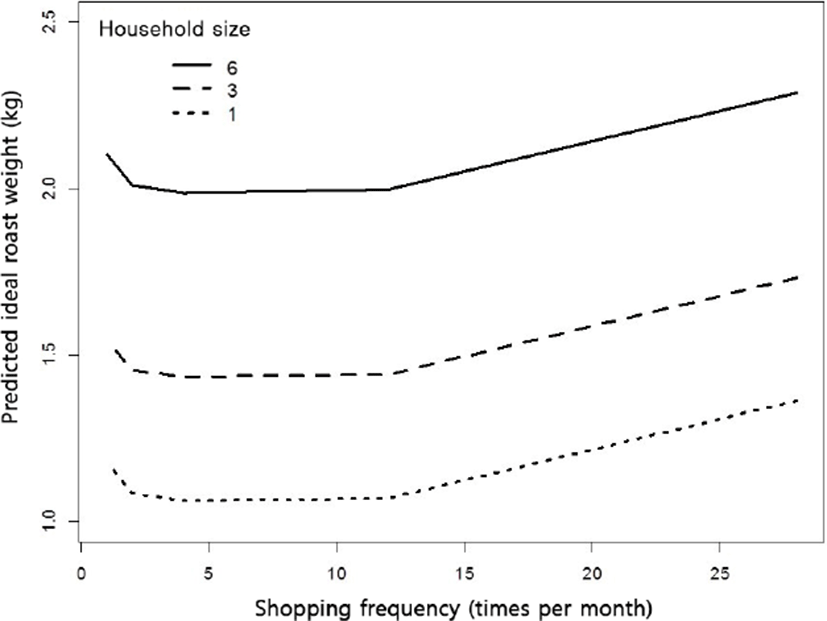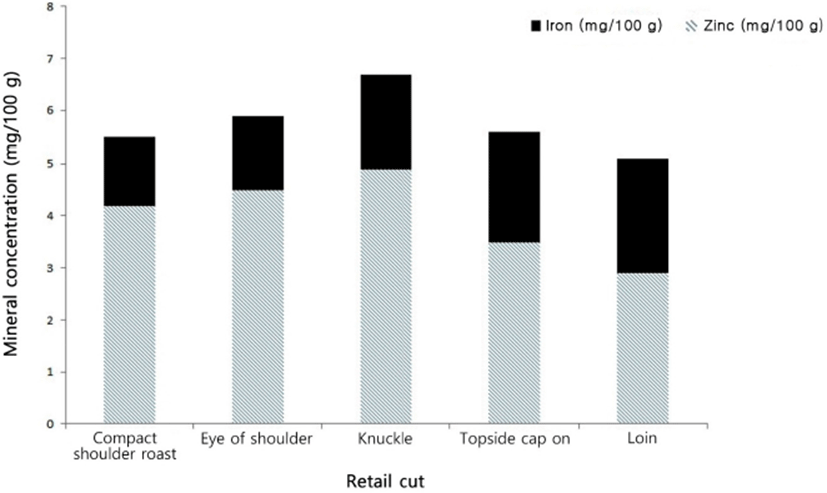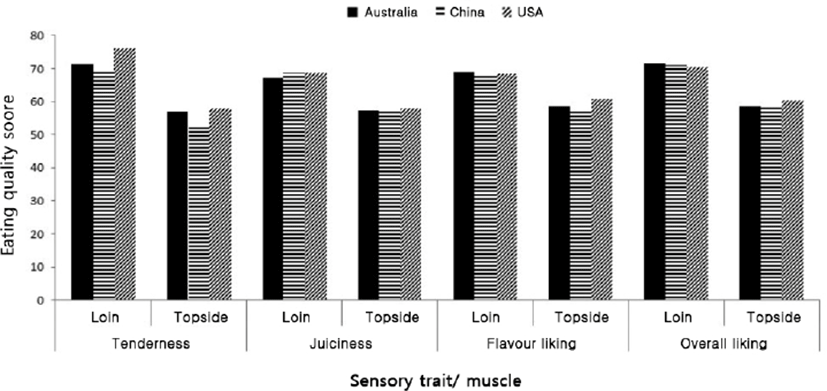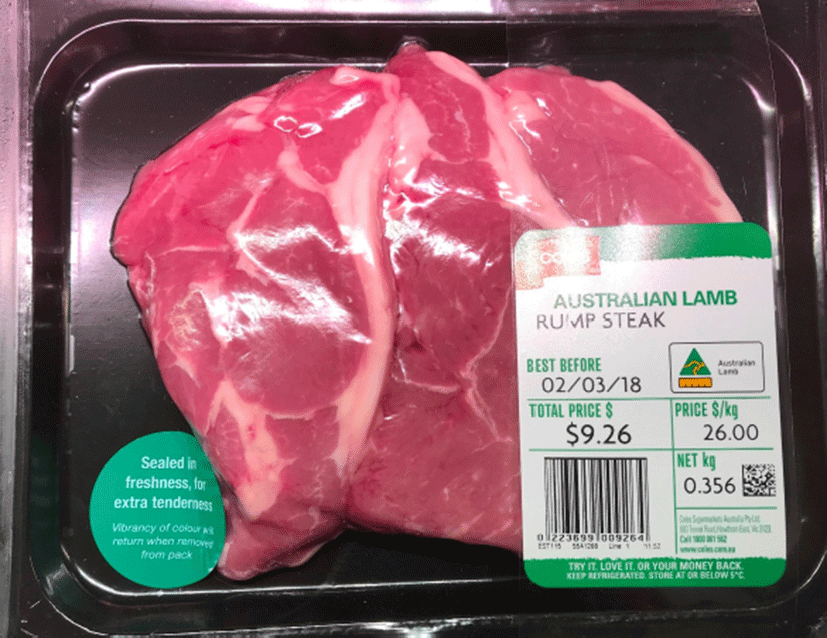Introduction
Consumption of lamb and sheep meat has long been considered part of the national identity of Australia as the Australian economy “rode on the sheep’s back” giving the country one of the highest living standards in the world post WWII (Lipovic et al., 2015). Consequently, lamb has been incorporated into meals which have influenced Australian food culture, such as the roast dinner, traditionally a British meal. However, by the 1980’s the consumption of lamb was showing a decline from as high as 30 kg per head to around 15 kg per head (Currie and Thatcher, 1988) and this was attributed to a product that was too fat, had too much bone and lacked versatilty (Currie, 1986). Early product testing (Hopkins and Congram, 1985b) showed that the majority of consumers (75%) preferred lamb from lean carcases (Fatscore 2: a GR tissue depth measure of 6–10 mm) and from carcases weighing more than 20 kg. This conclusion was based on survey of 350 households in each of two Australian cities Brisbane and Melbourne (Hopkins and Congram, 1985a), which showed that the main reasons for consumers not buying lamb was overfatness (18%) and poor value for money (15%), but the main reasons for people buying lamb was they liked the flavour and considered it tasty and sweet (27%). Furthermore, lamb was considered to provide variety in contrast to other meats (28%). A core response to these findings was to increase the carcase weight of Australian lambs while reducing fat levels to facilitate the cost effective preparation of new cuts ready to be sold at the retail level.
Consumers have also continued to change since the 1980’s, as household sizes have become smaller (Australian Institute of Family Studies, 2016) and consumers have become more influential in food supply chains by exercising greater choice while shopping. Furthermore, societal expectations of women have also changed as more women have become employed and are living independantly. Consequently, the long accepted sociteal rules around eating, such as sit down meals every night have been altered and the availability of convience foods has increased (Dixon, 2002). Attitudes towards food have also changed as consumers become more concious of their choices, seeking higher quality and nutritive value from foods (Lang and Heasman, 2004). These factors have been the stimulus for changes at the production, processing and retailing sectors within the lamb value chain and this paper will provide an overview of these changes.
Increasing carcase weight and reducing fatness
The establishment of the NSW Meat Sheep Testing Service (MSTS) (Harris, 1985) was the foundation of genetic improvement programs that were to follow in Australia and this lead to the development of LAMBPLAN which was launched in 1989 (Banks, 1990). LAMBPLAN has undergone continuous improvement providing Australia with a world leading performance recording and genetic evaluation system that started with Terminal sire breeds (Fogarty, 2009). This system has been expanded to encompass all breeds including the Merino under the banner of MERINOSELECT through Sheep Genetics (Brown et al., 2007). For various reasons the genetic progress amongst Terminal sire breeds has been the greatest as outlined by Swan et al. (2009) and this has enabled even greater gains in crossbred lamb production as genetic progress has also occurred in the Maternal breeds like the Border Leicester (Swan et al., 2009).
With this and improved management practices the carcase weights of Australian lamb has shown steady increase from a mean carcase weight of ~17 kgs to a mean carcase weight of ~23 kgs (Pattinson et al., 2015) and there are no signs that this trend is going to abate. This has also allowed the production of leaner carcases, but as a consequence has provided another challenge; how to deal with increasingly heavier cuts. For example, traditional lamb cuts, such as a whole shoulder and leg roasts, have become larger and consequently have less appeal to consumers. This was inevitable based on the early work reported by Hopkins and Congram (1985b) where legs from carcases weighing between 16.5–20 kg were preferred.
Development of new cuts
The development of new cuts lead to a departure from traditional bone-in, fat on cuts. These cuts included short leg roast, leg schnitzels, loin valentine steaks and a forequarter roll (Currie and Thatcher, 1988) and intial consumer response was positive. Despite consumer interest, retailers where less enthusiasic citing increased time to prepare the cuts and reduced whole carcase saleable meat yield as issues. Further consumer study showed that consumers preferrred (60%) loin chops to valentine chops/steaks and 73% preferred bone-out as opposed to bone-in forequarters (Hopkins et al., 1992). This suggested that newer alternative cuts were probably required, which lead to the development of the ‘Trim Lamb’ cuts (Hopkins et al., 1995).
The creation of value-added retail cuts is one method of increasing consumer appeal, as value-adding uses special manufacturing, processing and marketing to alter the characteristics of meat products thereby increasing the prices consumers are willing to pay for products (Dixon, 2002). At the time despite a massive marketing campagain the market penetration of the ‘Trim Lamb’ cuts was limited, as value-added leg cuts such as the knuckle were found to oxidise rapidly. However the advent of new packaging systems has assisted the re-emergence of the “Trim lamb” cuts, as it has been able to overcome this limitation. This re-emergence has also been linked to the increase of 1–2 person households and their preference for lighter roast cuts (Hopkins et al., 2018). Thus, interest from processors and retailers in value-added cuts including the knuckle, outside, topside, silverside and eye of shoulder has increased. Also new cut options based on the incorporation of different marinades have emerged. These “new” cuts such as various versions of boned and butterflied forequarters are prepared within retail companies and thus preparation methods are not described.
To provide the whole of industry with options for reducing the weight of cuts from the forequarter (shoulder) a survey was undertaken to establish consumer attitudes towards lamb shoulder roasts with a focus on the weight (Hopkins et al., 2018). A total of 868 respondents participated in this study and they represented a range of demographics, with more respondents being female and the majority of respondents being in the 30–49 age group. As the number in a household increased the “ideal weight” of a roast increased (p<0.001: Fig. 1), and there was an impact on the ‘ideal weight’ of the frequency of shopping (p<0.001: Fig. 1) such that respondents who shopped daily preferred the heaviest roasts. The 30–64 year-old respondents preferred the heaviest roasts (p<0.001), with the 18–29 and over 65 year age groups preferring the lighter roasts. The lower weight considered ideal for these age groups would suggest a preference for smaller cuts. Bernués et al. (2012) also support this as young Spanish lamb consumers showed a preference for eating out and less traditional cooking of lamb, as lifestyles, education and income have impacted on their food choices.

Furthermore, households with less people also have a preference for lighter roasts with an ideal weight of ~1.0 kg. These findings support the development of new smaller forequarter lamb roasts in line with the increase in 1–2 person households, with one survey of more than 5,000 Australian consumers recording that 49% of respondents were from two-adult no children households (Tighe et al., 2017).
Based on this knowledge a new cut from the forequarter was developed called the compact shoulder roast (CSR), adapted from the pork Boston butt and with full preparation specifications provided to industry, making the cut available to all of industry and aiding the adoption of this novel cut. The CSR is created by further value adding a square cut shoulder, with the neck and the top of the leg removed by cutting between the scapula and the humerus (Anonymous, 2016). The four rib rack is removed and the scapula can be boned out for a boneless option. This cut is perfect for roasting or slow cooking for a pulled lamb cut which is currently popular with consumers.
Focus on eating quality
In 1997–1998 a national quality audit of lamb at the retail level with particular emphasis on tenderness was undertaken (Safari et al., 2002) in which 909 lamb loins (derived from a cut through the M. longissimus lumborum caudal to the 6th lumbar vertebra and caudal to the 12th and 13th thoracic ribs) were purchased from a total of 137 different outlets in Canberra, Melbourne, Perth, and Sydney on four occasions over 12 months.
The frequency distribution for shear force of the loins showed that overall, 20.3% of loins (n=184) recorded shear force values above 49 N, a threshold above which Shorthose et al. (1986) suggested Australian consumers would consider lamb to be unacceptably tough. A higher proportion of lamb sourced from Melbourne and Perth contributed to the percentage of loins with shear force values above 49 N (42% and 31%, respectively). If the latest estimate of 30 N was applied as a consumer acceptable threshold for shear force (Hopkins et al., 2006) then an even higher percentage (49%) of the lamb would have been above the threshold. This highlighted that there was potential to improve the tenderness of lamb at the retail level and this was the first step in the establishment of a multi-organisational program of research to establish an eating quality scheme for sheep meat across Australia (Russell et al., 2005) which is now called Meat Standards Australia (MSA) for sheep meat. This program developed standard protocols for testing sheep meat using Australian consumers of sheep meat and examined both production and processing factors that impinge on eating quality. Among those processing factors tested was the impact of electrical stimulation, because based on the results it was evident that an improvement was needed in the tenderness levels of lamb.
A new approach was developed to stimulate lamb carcasses such that each carcass is stimulated individually using segmented electrodes to ensure that each segment only contacts one carcass at a time. This allows computer-controlled electronics to give a precise, but adjustable electrical input to each carcass to match the requirements of a particular carcass type while maintaining the delivery of a predetermined level of current. Extensive testing and optimisation of this approach has been undertaken (Pearce et al., 2010).
Developments in packaging
Meat packaging is dynamic and its innovation has been the topic of much recent review (McMillin, 2017). The primary function of meat product packaging is to protect against oxygen, water vapour, UV light and both chemical and microbial interferences, with an ideal packaging achieving these while maintaining optimal product quality and viability over prolonged durations. There are 3 broad areas of packaging: Intelligent Packaging – this involves the inclusion of sensory instrumentation into/onto packaging to measure and report the status of its contents; Active Packaging – this is designed to interact with its contents dependent on shifts in content status and Preservative Packaging – this aims to prolong the longevity of the packaged contents and includes modified atmosphere packaging (MAP). MAP involves the replacement of the air surrounding a meat product with a formulated gas mix containing principally combinations of the following gases (i.e. N, O2, CO2) (Kerry et al., 2006). These are designed to limit meat spoilage and oxidation, and this extends product shelf-life. Vacuum packaging (VP) offers another means to achieve this without the negative effects of some gases on quality and combinations of MAP and VP are also available. In this area vacuum skin packaging (VSP) is a more recent development that is gaining widespread acceptance.
The development of VSP has overcome the reduction in eating quality reported with MAP (Frank et al., 2017), but further has provided an attractive way to retail lamb cuts as shown in Fig. 2.
In addition to the use of VSP there are is also a range of cuts ready to roast or cook with a myriad of added marinades. This is a huge shift in retailing from the lamb roast of the past and this is a response to consumer demand shifts for easier to cook products and with a variety of tastes to satisfy the changing demographics of the Australian population.
Latest consumer changes
Market research indicates that meat quality traits are becoming more important to consumers (Bermingham et al., 2008) and this will increase the focus on methods to improve them. Contemporary consumers are well informed about the nutritional characteristics of food and its effects on human health, thus increasing the focus on selection criteria of food that has a high nutritional value (Stein and Rodriguez Cerezo, 2008). Therefore, improvement of the nutritional value of lamb represents a market opportunity for the lamb industry, as nutritional characteristics are recognized as important traits by consumers (Bermingham et al., 2008; Lamb et al., 2010).
Given the claims that a greater ratio of polyunsaturated to saturated fat and a lower ratio of omega-6 to omega-3 in meat would be desirable to lower the incidence of human metabolic diseases such as heart disease and inflammation along with mental health issues (Wood et al., 2004; Scollan et al., 2006), it is important to develop both genetic and non-genetic approaches to manipulating the level of the omega-3 fatty acids. However to date in Australia there hasn’t been an overt demand for meat with higher levels of omega-3 fatty acids, but when asked whether this is deemed important a high percentage of consumers (62%) say that it is (Lamb et al., 2010). Interestingly those over 50 or younger than 20 were more likely to consider this an important trait and understandably the importance declined as consumption per week increased. There are a number of brands in Australia that now advertise as being based on grass finishing which will produce higher levels of these fatty acids (Ponnampalam et al., 2014). With a continual growth of organic and “natural” production systems driven by consumer demand the nutrient content of lamb meat is likely to increase in importance and based on recent data, grass fed lamb across a range of cuts can be considered a “source” of health claimable omega-3 fatty acids (Fowler et al., 2018b).
Apart from fatty acids, mineral content is a trait of importance for human health, but for Australian lamb, until recently there was only sparse data on the level of key minerals like iron and zinc which was highlighted when a compilation of all current Australian lamb cuts was produced (Hopkins et al., 2016). Iron is a component of several important proteins such as haemoglobin and myoglobin and has many biological functions, including the transport and storage of oxygen (Czerwonka and Tokarz, 2017). Zinc is a component of various enzymes that help maintain structural integrity of proteins and regulates gene expression and the omega-3 fatty acids, particularly eicosapentaenoic (EPA) and docosahexaenoic (DHA), which have cardiovascular and anti-inflammatory benefits (NHMRC, 2006). Pannier et al. (2014) reported based on a large study of 5,625 lambs produced in different regions across Australia that the mean iron level in the loin was 2.03±0.36 mg/100 g muscle and for zinc it was 2.43±0.44 mg/100 g which was approximately half that previously reported from retail sampling of lamb in Australia (Williams, 2007) and elsewhere (Lin et al., 1988).
Given that there was no data on other cuts a recent study was undertaken to sample a range of lamb cuts (Fowler et al., 2018a). Retail cuts were sampled from representative carcases selected from over 350 mixed sex lambs from extensive production systems over 5 consecutive months. These lambs were verified to have been raised solely in extensive systems with no grain supplementation to represent lambs typically produced in extensive systems within Australia. At 24 h post mortem the CSR (Anonymous, 2016), eye of shoulder (Anonymous, 2016), loin (HAM 5051; Aus-Meat, 2005), knuckle (HAM 5072; Aus-Meat, 2005) and topside cap on (HAM 5073; Aus-Meat, 2005) were collected from 25 carcases (5 carcases per sampling from August to September 2016) representing a range in carcase weights (19.5–25.8 kg) and fat depths (GR tissue depth 5–16 mm). These were tested for nutritional composition, including iron and zinc.
The zinc content was significantly higher in the leg and shoulder cuts compared to the loin. The zinc concentrations measured in the loin were similar to the 2.4 mg/100 g reported by Pannier et al. (2014). However, the zinc concentration measured in the CSR, eye of shoulder and knuckle were almost double these levels (Fig. 3). It is hypothesised that this is due to the physiological differences between cuts which contain postural muscles, such as the loin, and those which contain locomotive muscles, such as the knuckle, that have a higher demand for zinc required for catalytic, structural and regulatory functions within the muscle (CSIRO, 2007). Given that the recommended daily intake (RDI) for zinc is 8 mg for women and 14 mg for men, a standard serve (100 g) of CSR, eye of shoulder and knuckle can all be considered a “good source” of zinc for both men and women while topside cap on and loin from this study can be considered a “source” under current guidelines (NHMRC, 2006). The different levels across cuts, provides the scope to market specific cuts to meet nutritional requirements and offers greater flexibility to retailers. The concentration of iron found in the current study for the loin was similar to the 2.0 mg/100 g fresh meat reported previously for Australian lambs (Pannier et al., 2014). The loin, topside and knuckle yielded higher iron content compared to the shoulder cuts (Fig. 3) and there was a broad reversal in level compared with zinc such that forequarter cuts had lower iron levels. This creates a challenge for marketing in the sense of being able to retail specific cuts as high in both minerals, but doesn’t prevent selective marketing of cuts in a “fit for purpose” sense.

As mentioned the demographics of the Australian population has shown a significant move from an Anglo background to being very diverse. Australians now come from nearly 200 countries, and represent more than 300 ethnic ancestries. One in four people in Australia (26%) now were born overseas, a one percentage point rise in 2017 from the figure recorded in 2011 (Anonymous, 2018).
Linked to these demographic changes the export of Australian lamb to overseas countries has grown with the latest growth in the Asian region, matched by the highest immigration from this region. For example the proportion of migrants born in Asia has increased–from 24% of the overseas-born population in 2001 to 33% in 2011, and 40% in 2016 (Anonymous, 2018). As part of extending MSA sheep meat new cooking techniques, other than grilling and roasting, have been investigated. For example, the traditional style Chinese hot-pot method (or locally referred to as ‘huoguo’) is being tested to determine the suitability of specific Australian sheep cuts for this style of cooking for the Chinese market. Lamb has also been tested using more traditional cooking methods in both China and the USA. Based on the results shown in Fig. 4 it is evident that consumers from the 3 countries rate the two cuts similarly although the Chinese consumers considered the topside tougher than consumers from Australia and the USA. Since all the cuts tested are heavily denuded of fat, it does raise the question as to whether the differences would be greater if more fat was retained on the cuts, given this is the major depot of volatiles and flavor compounds (Young et al., 1997). This is because many Chinese do not like the flavor of sheep meat (Mao et al., 2016), but there are also significant differences across the regions of China in people’s consumption of sheep meat and within age groups, with those in the 40–49 age group consuming the highest levels of sheep meat away from home because they have higher incomes (Mao et al., 2016). These differences in consumption which are linked to demographics highlights the need to understand this market in order to grow the level of Australian lamb consumed, which can contribute to meeting the rising demand within China (Mao et al., 2016).

Research to develop the MSA sheep meat program has been driven by the knowledge that the eating quality of lamb could be improved and that the fact that Australian consumers are seemingly willing to pay 1.4 and 1.9 times more for the 4- and 5- star quality, relative to the 3 star (Tighe et al., 2017). This illustrates there is demand for high quality lamb and in the space of 30 years this represents a significant shift in consumer attitudes. The challenge remains to see differentiation in price at the retail level based on expected eating quality, so there is more development to come.
Conclusions
Australian lamb has changed significantly over the last 30 years from a product lacking diversity and carrying too much fat, to a product that can be tailored to the higher income smaller families found in the major cities. The range of cuts continues to grow and there is scope to further develop new cuts that satisfy the changing consumer base. Unless lamb continues to be developed and improved by focussing on its strong traits like iron and zinc content and improved eating quality domestic consumption will decline as on a dollar per protein basis it is now a relatively expensive cut. There is scope to grow the export market and there exits potential to develop products that overcome the flavour issues in some importing countries.














